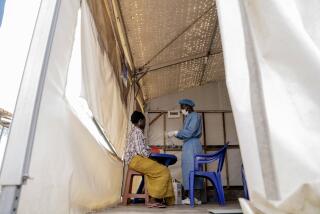Virulent Chlamydia Detected Largely Among Gay Men in U.S.
- Share via
An unusually virulent form of chlamydia has emerged in the United States, primarily among gay men, after an outbreak in Europe two years ago, federal researchers said Wednesday.
There are about 80 confirmed cases in the U.S., but infectious-disease experts fear the actual number is substantially larger because this form of chlamydia is difficult to diagnose and many physicians are not aware of its existence.
Officials are concerned because the disease, like many other sexually transmitted diseases, can accelerate the spread of HIV infections and perhaps enhance replication of HIV in people who are co-infected.
Lymphogranuloma venereum, or LGV, is caused by three strains of the bacterium Chlamydia trachomatis -- strains that are different from those that cause regular chlamydia infections or eye diseases.
Symptoms include bleeding, inflammation of the rectum and colon, and abdominal cramping. Infection can be fatal if left untreated.
It can be cured with antibiotics such as doxycycline, but three weeks of treatment are required -- substantially longer than what is required for common genital chlamydia.
The disease is most prevalent in parts of Asia, Africa and South America along the equator, but it made an unexpected appearance in Europe in 2004. The Netherlands, which normally had seen four or five cases per year, suddenly began to see two cases per week; other European countries reported similar experiences.
Since then, LGV has shown up in the United States and Canada, generally in cities with a high prevalence of other sexually transmitted diseases.
Dr. Preeti Pathela of the New York City Department of Health and Mental Hygiene said at a sexually transmitted diseases meeting in Florida that her laboratory had confirmed 31 cases of the disease in the last year, 30 of them in gay men.
The Centers for Disease Control and Prevention has confirmed 30 cases nationwide, all in gay men, and the San Francisco Department of Public Health about 20.
But those numbers are “undoubtedly widely underestimated,” said Dr. Ron Ballard, branch chief of the CDC’s sexually transmitted diseases laboratory. “Many cases are not suspected, and many of those suspected are not tested.”
There is also no requirement for notification of authorities when cases are observed.
Testing has been a problem because it involves sequencing part of the genome of the bacterium, a task that requires several days and a sophisticated laboratory.
Because of the time needed for testing and the dangers that come with infection, Dr. John Douglas, director of the CDC’s Division of STD Prevention, said physicians should “presumptively treat suspected cases” as though they had been confirmed.
Diagnosis may soon be easier because CDC technicians have developed a genetic test that takes only a few hours and can be done in most laboratories.
It is still experimental and is being used only at the CDC, Douglas said, but if the test is proved, it will be offered to other labs.






